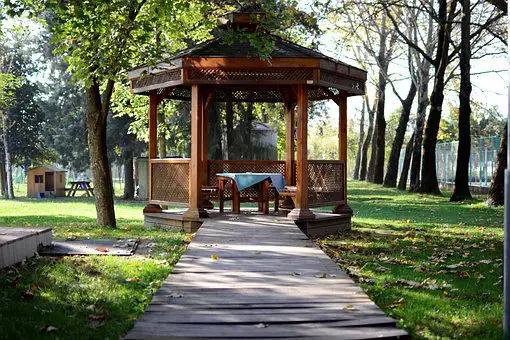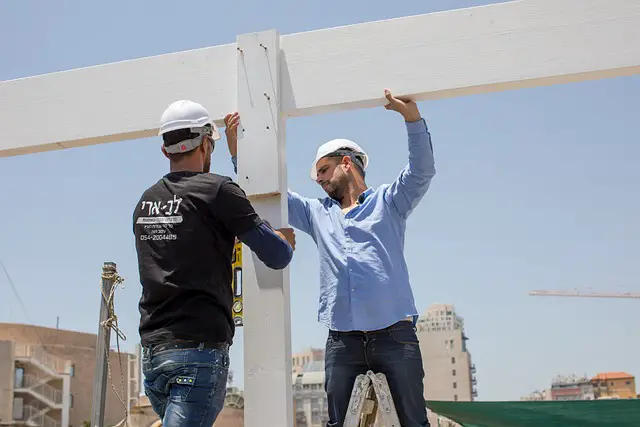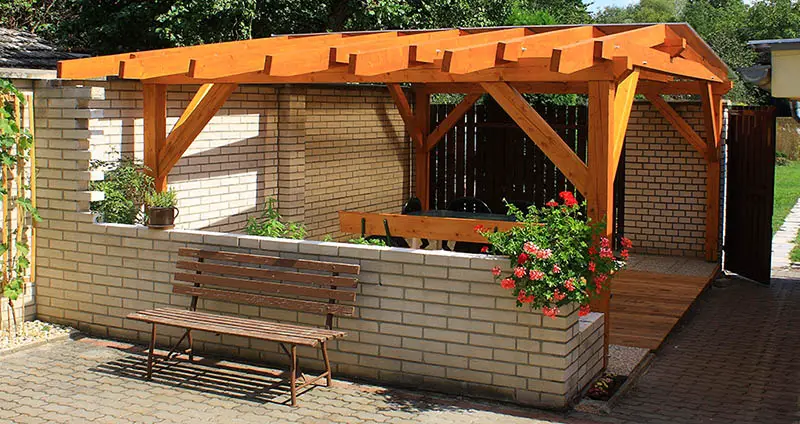Adding a roof to your pergola can provide more protection from the elements and give you an outdoor space that’s comfortable all year round. But when it comes to choosing a roof for your pergola, there are many factors to consider – type of material, cost, installation requirements and maintenance needs.
In this blog post we explore the different types of roofs available for pergolas as well as their benefits and associated costs so you can make an informed decision about which one is right for you.
We also cover how to install a roof yourself if desired or necessary along with some tips on maintaining it over time. So read on if you want learn everything there is know about roofs for pergolas!
Table of Contents:
- Types of Roofs for Pergolas
- Benefits of Installing a Roof on Your Pergola
- Cost Considerations for Installing a Pergola Roof
- How to Install a Pergola Roof Yourself
- Maintenance Tips for Your Pergola Roof
- FAQs in Relation to Roof for Pergola
- Conclusion
Types of Roofs for Pergolas
Polycarbonate Roofs: Polycarbonate is a lightweight, durable material that is often used for roofing applications. It is available in a variety of colors and styles, making it an ideal choice for pergolas. The panels are easy to install and can be cut to fit the exact size of your pergola.
Polycarbonate roofs provide excellent protection from the elements, such as UV rays and rain, while still allowing light to pass through them. They are also relatively inexpensive compared to other types of roofing materials.

Metal Roofs: Metal roofs offer superior durability and strength when compared with other materials like polycarbonate or fabric. They come in many different colors and finishes so you can find one that best suits your needs.
Metal roofs are more expensive than polycarbonate but they last longer and require less maintenance over time. Additionally, metal roofs provide excellent insulation against heat loss during cold weather months.
Fabric roofs are becoming increasingly popular due to their versatility and affordability when compared with other options like metal or polycarbonate sheets. These fabrics come in various weights depending on how much sun protection you need from them; some even have waterproof coatings which make them perfect for rainy climates.
Fabric roofs also allow natural light into the area below them without sacrificing privacy or security, since they’re usually made from opaque materials like canvas or vinyl-coated mesh screens.
From the traditional to the modern, there are many types of roofs for pergolas available. Each type has its own unique benefits and drawbacks that should be taken into consideration when deciding which roofing option is best for your needs. Let’s take a closer look at some of these options in the next section.
Benefits of Installing a Roof on Your Pergola

Installing a roof on your pergola can provide many benefits that will add value to your home or business.
Protection from the Elements: A roof over your pergola offers protection from rain, snow, and other harsh weather conditions. This can help extend the life of furniture and plants underneath it while also providing an area for outdoor entertaining even in inclement weather.
Additionally, a roof can reduce energy costs by blocking out direct sunlight during hot summer months.
Increased Privacy and Security: Installing a roof on your pergola provides more privacy than an open structure alone would offer. It also helps protect against unwanted intruders as well as animals such as birds or squirrels that may try to make their way into the space below it.
The addition of a roof to your pergola adds visual interest to any outdoor living space with its unique design elements like rafters, beams, posts, and purlins which create interesting shadows when illuminated by natural light or artificial lighting at night time.
Furthermore, this type of feature is sure to increase curb appeal if you are looking to sell your property in the future.
Installing a roof on your pergola provides many benefits, including protection from the elements, increased privacy and security, and improved aesthetics. In the next section we will discuss cost considerations for installing a pergola roof.
Cost Considerations for Installing a Pergola Roof

Installing a pergola roof can be an expensive undertaking, so it’s important to understand the costs associated with the project before you begin. The material and labor costs for installing a pergola roof will vary depending on your location, the size of your structure, and the type of materials used. Here are some cost considerations to keep in mind when planning your project.
Material Costs: The cost of materials is one of the most significant factors in determining how much it will cost to install a pergola roof. Polycarbonate roofs are typically more affordable than metal or fabric roofs, but they may not provide as much protection from weather elements such as rain and snow.
Metal roofs tend to be more durable and long-lasting than other types of roofs, but they also come with higher price tags. Fabric roofs offer excellent protection from UV rays while remaining lightweight and easy to install; however, these materials can be quite costly compared to other options.
Labor Costs: Labor costs for installing a pergola roof depend on several factors including size, complexity of installation process (such as if scaffolding needs to be set up), number of workers needed for installation process etc.. It’s best practice to get quotes from multiple contractors before making any decisions about who should do the work on your project.
Additional Expenses To Consider: In addition to material and labor costs there are additional expenses that need consideration when budgeting for this type of project such as tools required for installation like ladders or scaffolding equipment which can add up quickly depending on what is needed.
Additionally , permits may need acquired prior beginning construction so make sure you factor those into budget plans too .
Finally, remember that taking time during pre-planning stages could help save money down the line by researching different suppliers who might have better deals available or finding ways to reduce overall scope without sacrificing quality.
When considering the cost of installing a pergola roof, it is important to factor in material costs, labor costs and additional expenses. With proper preparation and knowledge, you can successfully install a pergola roof yourself – let’s look at how.
How to Install a Pergola Roof Yourself

Installing a pergola roof yourself can be a rewarding and cost-effective project. Before beginning, it’s important to gather the necessary materials and tools for the job.
This includes roofing material such as polycarbonate, metal or fabric panels, fasteners such as screws or nails, and any other supplies needed for installation. It’s also helpful to have an assistant on hand to help with lifting and maneuvering the panels into place.
Once you have all of your materials ready, it’s time to prepare the area for installation. Start by measuring out where each panel will go so that you know exactly how much material is needed.
Then clear away any debris from around the perimeter of your pergola structure so that there are no obstructions when installing the roofing material.
Finally, it’s time to install the roofing material properly. Depending on what type of material you are using (polycarbonate, metal or fabric), follow specific instructions outlined in product manuals or online tutorials before attaching them securely with fasteners like screws or nails along their edges and corners.
Be sure not to overtighten these fasteners as this could damage your panels over time. Once everything is in place double check all connections before moving onto maintenance tips for your new pergola roof.
Installing a pergola roof is a relatively simple process, but it requires attention to detail and the right materials. With proper maintenance, your pergola roof will last for years to come. Now let’s take a look at how you can maintain your new roof properly.
Maintenance Tips for Your Pergola Roof

Maintaining your pergola roof is essential for keeping it looking its best and ensuring that it continues to provide the protection you need from the elements. Here are some tips on how to keep your pergola roof in top condition:
Regular Cleaning and Inspections: Regularly cleaning and inspecting your pergola roof can help prevent damage caused by debris buildup or pests. Make sure to clean off any dirt, leaves, or other debris that has accumulated on the surface of the roof.
Also inspect for signs of wear and tear such as cracks, holes, or rust spots. If you notice any issues, make sure to address them promptly before they become more serious problems.
Repair or Replace Damaged Components: If there are any damaged components on your pergola roof such as broken tiles or missing shingles, be sure to repair them right away so that they don’t cause further damage down the line.
In some cases, it may be necessary to replace entire sections of the roof if they have been severely damaged beyond repair.
Protect Against Pests and Debris: To protect against pests like birds or rodents nesting in your pergola roof, consider installing mesh netting over vulnerable areas where animals could enter through gaps between boards or tiles. Additionally, trimming back trees near your structure can help reduce leaf accumulation which can lead to water pooling up on top of the structure during heavy rains.
Finally make sure all gutters are clear so rainwater doesn’t overflow onto surfaces below causing potential damage due to moisture build-up over time .
By following these maintenance tips for your pergola roof, you will ensure that it remains in good condition for years to come while also providing a beautiful addition to your outdoor living space.
FAQs in Relation to Roof for Pergola
What kind of roof should I use for a pergola?
When building a pergola, the best type of roof to use is one that offers protection from the elements while still allowing light and air to pass through. A polycarbonate sheeting or corrugated metal roof are both good options for this purpose.
Polycarbonate sheets are lightweight and durable, making them easy to install and maintain. Corrugated metal roofs provide more durability than polycarbonate but can be heavier and harder to install. Both types of roofing offer excellent weather resistance, so you can rest assured your pergola will remain safe in any climate.
Can you buy a roof for a pergola?
Yes, you can buy a roof for a pergola. There are several types of roofs available that are suitable for use on pergolas, including aluminum, steel, and polycarbonate panels. Each type has its own advantages and disadvantages depending on the climate and location of your home.
Additionally, it is important to consider the cost of installation when selecting a roofing material for your pergola. It is also recommended to consult with an experienced contractor or architect before making any decisions about purchasing a roof for your pergola.
How much does a pergola roof cost?
The cost of a pergola roof can vary greatly depending on the size, materials used, and labor involved. Generally speaking, a basic 10×10 foot wooden pergola with an aluminum or vinyl roof will cost between $2,000 and $3,500.
If you choose to use more expensive materials such as cedar wood or metal for your pergola roofing material then the price could be higher. Additionally, if you hire a professional contractor to install the roof it may add additional costs for labor and supplies.
What material can you use to cover a pergola?
When it comes to covering a pergola, there are several options available. Depending on the desired look and feel, you can choose from materials such as wood shingles or shakes, metal roofing panels, asphalt shingles, slate tiles or synthetic materials like PVC or polycarbonate.
Each material has its own unique benefits and drawbacks in terms of cost, durability and maintenance requirements. It is important to research each option thoroughly before making a decision so that you can find the best fit for your needs.
Conclusion
In conclusion, installing a roof on your pergola is an excellent way to extend the life of your outdoor space and add value to your home. With proper planning and installation, you can enjoy a waterproof pergola roof that will last for years.
Whether you choose to install it yourself or hire a professional contractor, make sure you consider all the cost factors before making any decisions. Finally, don’t forget about maintenance; regular inspections and repairs are essential for keeping your roof for pergola in good condition over time.
Are you looking for the perfect roofing solution to complete your pergola project? Look no further! Myrooff is here to help. Our website provides detailed information and step-by-step instructions on all aspects of building a strong, durable and attractive roof.
From choosing the right materials to understanding local regulations, we have everything you need in one place. So don’t wait any longer – start exploring our resources today and find out how easy it can be build your dream pergola with confidence!
